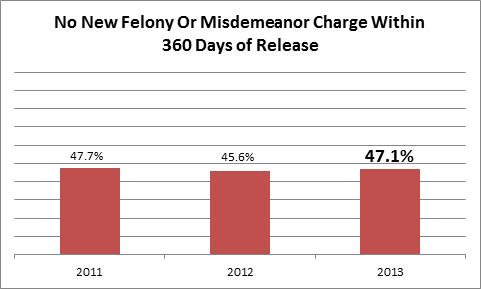The Community Programs program provides services to youth, their families, and the community along the Wasatch Front. Most clients are from the Second, Third, and Fourth Juvenile Court districts.
Services include:
- Case management.
- Community-based programs.
- Aftercare/transition programs.
All programs have been or are being developed around the Balanced and Restorative Justice Model.
During the 2015 General Session, the Legislature appropriated for Fiscal Year 2016, $24,517,200 from all sources for Community Programs. This is a 1.1 percent reduction from Fiscal Year 2015 revised estimated amounts from all sources. The total includes $22,871,200 from the General/Education Funds, an increase of 0.1 percent from revised Fiscal Year 2015 estimates.
In addition to statewide compensation and internal service fund cost increases, the following appropriation adjustments were made during the 2015 General Session:
Percent of youth without a new felony charge within 360 days of release
Case Management
- Percent of Youth without a New Felony Charge within 360 Days of Release. This measure identifies youth recidivism after program completion. This measures the program's ability to suppress youths' further penetration into the juvenile justice system and to keep the community safe from more serious offenses.
FY 2013 Results:
Total Admissions: 1,022 Different Youth Served: 1,879 Males Admitted: 812 Females Admitted: 210 Average Length of Stay: 344.5 Days
- Percent of Youth without a New Felony or Misdemeanor Charge within 360 Days of Release. This measure identifies youth recidivism after program completion. This measures the program's ability to suppress youths' further penetration into the juvenile justice system and to keep the community safe from more serious offenses.

- In-Program Protection--Percent of Youth Felony Free While in the Program. This measures the program's effectiveness at keeping the youth crime free during their stay in the program.

- In-Program Protection--Percent of Youth Felony and Misdemeanor Free While in the Program. This measures the program's effectiveness at keeping the youth crime free during their stay in the program.

Community Placements
- Percent of Youth without a New Felony Charge within 360 Days of Release. This measure identifies youth recidivism after program completion. This measures the program's ability to suppress youths' further penetration into the juvenile justice system and to keep the community safe from more serious offenses.

- Percent of Youth without a New Felony or Misdemeanor Charge within 360 Days of Release. This measure identifies youth recidivism after program completion. This measures the program's ability to suppress youths' further penetration into the juvenile justice system and to keep the community safe from more serious offenses.

- In-Program Protection--Percent of Youth Felony Free While in the Program. This measures the program's effectiveness at keeping the youth crime free during their stay in the program.

- In-Program Protection--Percent of Youth Felony and Misdemeanor Free While in the Program. This measures the program's effectiveness at keeping the youth crime free during their stay in the program.

Transition
- Percent of Youth without a New Felony Charge within 360 Days of Release. This measure identifies youth recidivism after program completion. This measures the program's ability to suppress youths' further penetration into the juvenile justice system and to keep the community safe from more serious offenses.
FY 2013 Results:
Total Admissions: 689 Different Youth Served: 586 Males Admitted: 563 Females Admitted: 126 Average Length of Stay: 83.6 Days
- Percent of Youth without a New Felony or Misdemeanor Charge within 360 Days of Release. This measure identifies youth recidivism after program completion. This measures the program's ability to suppress youths' further penetration into the juvenile justice system and to keep the community safe from more serious offenses.

- In-Program Protection--Percent of Youth Felony Free While in the Program. This measures the program's effectiveness at keeping the youth crime free during their stay in the program.

- In-Program Protection--Percent of Youth Felony and Misdemeanor Free While in the Program. This measures the program's effectiveness at keeping the youth crime free during their stay in the program.

Statutory authority for Community Programs is UCA 62A-7-104 and UCA 62A-7-701. These sections provide the general operating and procedural guidelines.
COBI contains unaudited data as presented to the Legislature by state agencies at the time of publication. For audited financial data see the State of Utah's Comprehensive Annual Financial Reports.